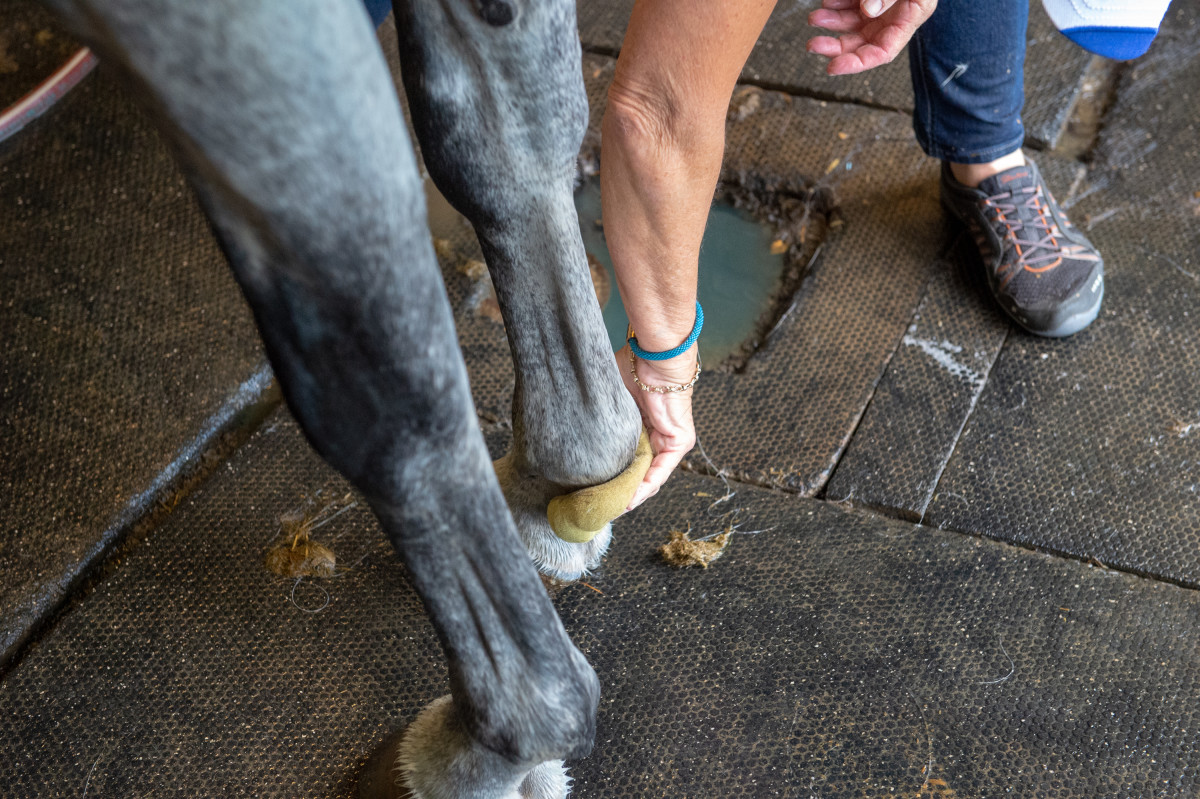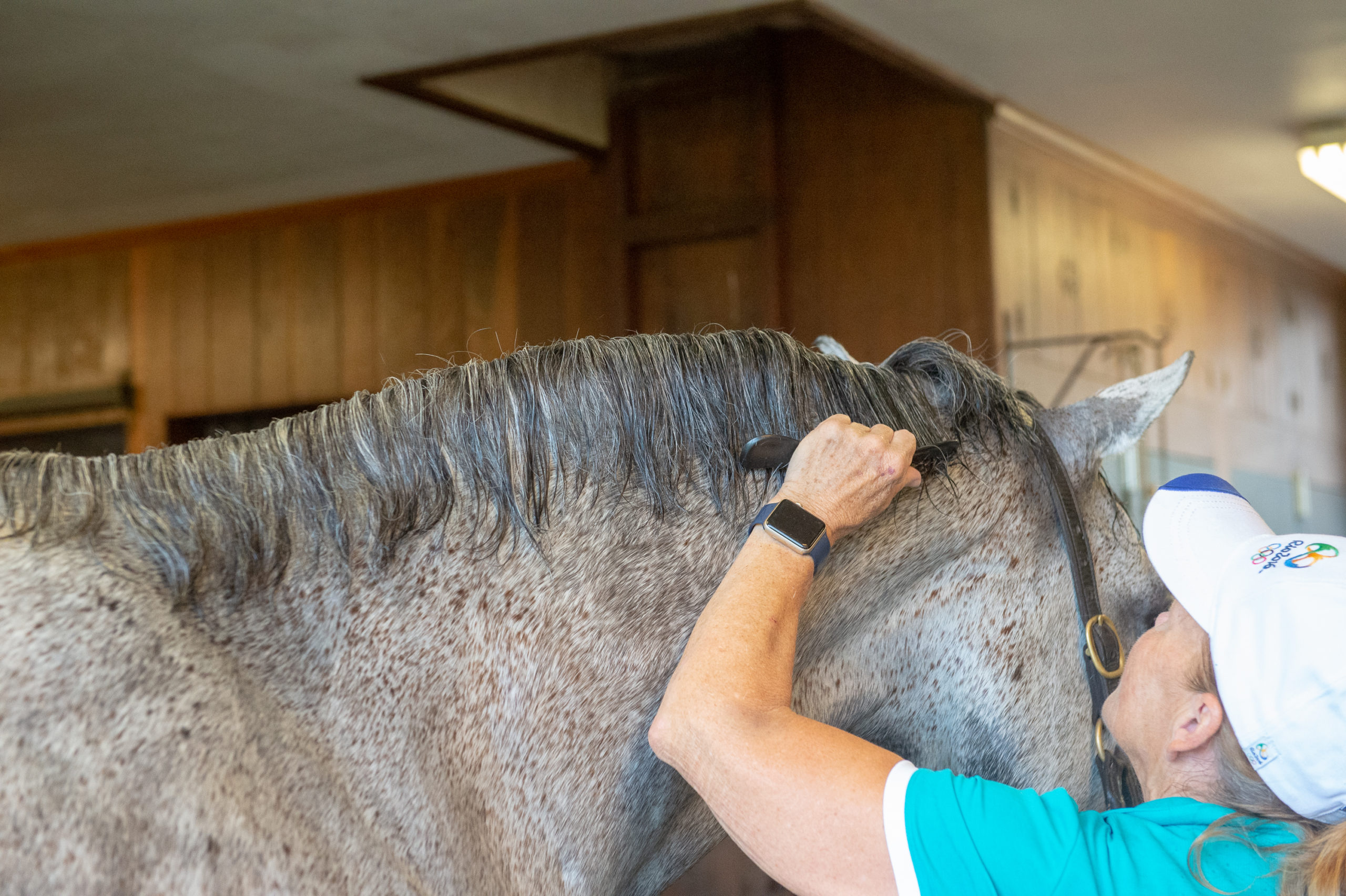If you love a sparkling-clean horse as much as I do, you might be tempted to bathe your horse frequently, even when you’re not showing. This can be beneficial: Dried sweat can lead to skin irritations, and really dirty, dusty horses tend to rub their manes and tails, breaking off hairs. But washing your horse too frequently or with caustic products can lead to dry skin and even cause hairs to fall out. During the hottest, stickiest part of the summer, it’s OK to rinse your horse off daily, but try to limit shampooing to just a few times per month, if possible. Save bluing or whitening shampoos and rinses for pre-show baths, unless you’re working on a really yellow tail, which might take multiple soaks/washings over several weeks to whiten.
As an Amazon Associate, Practical Horseman may earn an affiliate commission when you buy through links on our site. Product links are selected by Practical Horseman editors.
One of the main goals of bathing is to bring out the beautiful shine of a horse’s coat. Using an apple cider rinse after rinsing the shampoo off your horse is great for this. It cuts the soap residue and also helps to repel bugs.
If you’re preparing your horse for a show, go the extra mile to give him a really deep clean. Use scrubby mitts and sponges to loosen the dirt at the skin level, paying particular attention to the dock (the base of the tail) and the crest of the neck. When you put in your beautiful braids, your hands shouldn’t get dirty—and the visible skin between the braids should be perfectly clean.
Most importantly, always be sure to rinse the shampoo completely from your horse’s entire body. Soap residue not only dulls the coat, but it can cause itching and skin conditions.
What you’ll need:

• Hose with twist nozzle (not pictured)—I prefer this to a spray handle/trigger.
• Scrubby mitt or sponge with a scrubby side
• Shampoo
• Sweat scraper—I prefer a two-handed scraper or the smooth side of a shedding blade.
• Towel (not pictured)
• If you have a gray horse or a horse with white socks/stockings: a bluing/whitening shampoo or bluing rinse, such as Mrs. Stewart’s Liquid Bluing (available at grocery stores, country stores and tack stores) for pre-show bathing
Here are the basic bathing steps:
1. Use the hose to wet all of your horse’s body except his head.

2. Apply a liberal amount of shampoo directly to his mane and tail by hand and work it all the way down to the skin, paying special attention to the dock of the tail. Allow that to sit while you wash the rest of the body.

3. Fill the bucket with warm water and add an ounce or two of shampoo. Starting behind your horse’s ears, apply the sudsy water with your scrubby sponge or mitt and work it into the hair. (I don’t use a regular sponge for this step, because it doesn’t get through the hair to the skin.) Continue doing this over the rest of his body and legs on that side. Then shampoo the other side, starting again just behind
the ears and working your way over the entire body. (Always wash the whole horse before rinsing—no need to rinse in parts.)

4. Next, wash his face with a scrubby, working the shampoo into all the places that accumulate dirt and sweat. (If he’s really dirty, rinse out the bucket and refill it with fresh water and shampoo. Otherwise, continue with the original bucket of sudsy water.) Rub the suds into the forelock, the hair around his ears and eyes (trying to avoid getting shampoo in his eyes), the front of his face, and his cheeks and jaw. Wipe a damp sponge over the backs of his ears, taking special care not to squeeze water down into them. Horses are usually more worried about getting water into their ears than their eyes.

5. Rinse everything except the face with the hose. (Never spray the face with the hose. Horses quickly learn to distrust you handling their faces and ears if you do this.) Be sure to rinse the hair thoroughly. Twist the nozzle to increase the pressure over the mane to make sure you rinse all the shampoo out. If you can’t get enough pressure that way, fold the hose onto itself with your hand. When you finish, rub the mane and tail hairs between your fingers to check that there’s no remaining shampoo.

6. Next, rinse the bucket thoroughly and fill it with warm, clean water. Use your regular body sponge to squeeze fresh water over the face repeatedly until all the suds are gone.

7. Scrape the water off your horse’s body with the sweat scraper, down to his knees and hocks.

8. Rinse the regular body sponge completely and squeeze all the water out of it. Rub the sponge over the face to absorb as much water as possible. Repeat this several times, squeezing the water out of the sponge frequently. Then wring out the sponge until it’s almost completely dry and run it down the fronts and backs of your horse’s legs, wringing it out after each time.

9. Comb his forelock and mane so they lie flat.

10. Then spray his tail with detangler and comb it out very carefully, starting at the bottom and working your way up.

Rinse Options
After thoroughly rinsing the shampoo off your horse, consider using a diluted apple cider vinegar rinse to bring out the shine of his coat and repel bugs. The best way to clean a gray horse or get socks and stockings sparkling white is with a diluted bluing rinse. Use a white bucket so you can judge the color accurately (too much bluing can literally turn your horse blue!). You can combine vinegar and bluing in the same rinse.
About Laurie Pitts
In the 1970s and ’80s, Laurie Pitts worked for some of the top professionals in the country, including Joan Boyce, Frances Rowe, Rodney Jenkins, Joe Fargis and Conrad Homfeld. She traveled with the U.S. Equestrian Team to the 1978 World Championships in Aachen, Germany, the first World Cup in 1979 in Sweden and the 2016 Olympics in Rio de Janeiro, Brazil. Her favorite charge, Balbuco, ridden by Conrad, was also chosen for the 1980 Moscow Olympics. Laurie served as the barn manager for several U.S. Equestrian Federation-sponsored horsemastership clinics. She currently works for Brown Hall Farm in Middleburg, Virginia.











